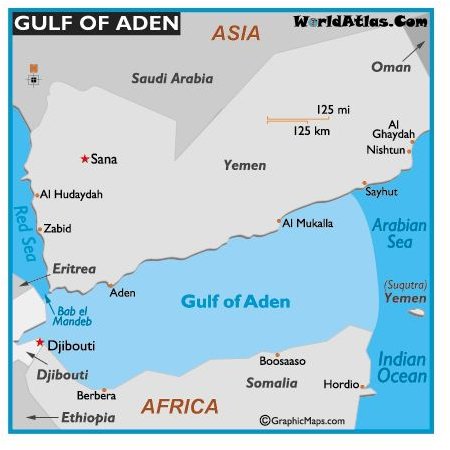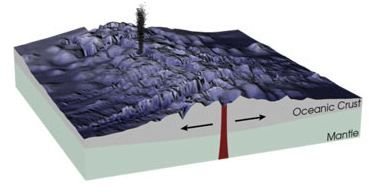Gulf of Aden Magnetic Anomaly Exposed
Before discussing the magnetic anomaly in the Gulf of Aden, learn some background on the Earth’s magnetic field and geological structures. This background attempts to explain why the magnetic phenomenon in the Gulf takes place.
Earth’s Magnetic Field
The Earth’s magnetic field results from the presence of iron in the center of the Earth. The inner core, a solid iron ball, spins in a faster rate than the Earth above it. The outer core, which lies on the top of the inner core, constitutes what can be called “an ocean of iron” that is an electrically conducting fluid in motion. The complex motion of the electric charges in the outer core results in a dynamo effect. This effect is explained by the generation of an electric current by the conducting fluid motion across an already existing magnetic field. The electric current also produces a magnetic field that interacts with the fluid and creates a new magnetic field. The resultant of the two fields is the Earth’s magnetic field.
The magnetic field is not constant and it is known that the magnetic poles move. Also, it is recorded that the field has decreased 10% since the 19th century, but this and other changes do not mean that the magnetic field of our planet is collapsing. Also, magnetic flips may take place, where the north and south poles change places.
Oceanic Ridges
An ocean ridge is an underwater system that consists of chain of mountains (undersea volcanoes), typically with a rift formed by tectonic plates. It represents an area where the plates move apart and a new ocean crust is formed with emerging magma, in a process that is known as sea-floor spreading.
The region where the oceanic crust is formed becomes magnetized in the direction of the Earth’s magnetic field.
The presence of basaltic layers (composed with titanomagnetite) in the crust is the main origin of marine magnetic anomalies. As the crust cools down reaching the Curie point of the magnetic minerals in its composition, the region presents magnetic properties. The Curie point is the temperature beyond which a ferromagnetic material becomes paramagnetic. Below this temperature, the magnetic moments in the material are aligned and provide magnetization even in the presence of a weak external field. A paramagnetic material is magnetized only in the presence of an external field and is not able to retain the magnetic domains aligned when the field is removed. It is caused by the thermal motion that causes a random orientation of the spins.
Gulf of Aden

The Gulf of Aden is located between the coast of Arabia and the Horn of Africa, at the opening of the Persian Gulf. The magnetic anomalies indicate that the sea floor in the Gulf is likely to have had three phases of spreading, so it has not been continuously formed.
A reversely magnetized sea floor was recognized in the region. The presence of reverse magnetization is suggested by observations of positive anomalies. The so-called “magnetic quiet zone” in the Gulf has a flat magnetic field in some areas and magnetic anomalies of up to several hundred gammas in other areas. One gamma (γ) corresponds to 1e-9 teslas (T).
Piracy is very common in the Gulf, which makes it a dangerous place for transport. People say there is a “Stargate” in the region. Probably the origin of the myth of the presence of a Stargate lies partly on the existence of magnetic anomalies and partly on the many acts of piracy that take place there, which brings a lot of warships to the region. There is also a lot of eyes on the area due to Al-Qaeda activity in Yemen and presence in the Gulf.
Some websites reported the supposed opening of an inter-dimensional portal in the Gulf of Aden in January, 2010. While looking for more information on this episode, all I could get from reliable sources was the report on an intense counter-piracy operation promoted by NATO (North Atlantic Treaty Organization).
References
NASA Science News - Earth’s Inconstant Magnetic Field
Nature - Gulf of Aden axial magnetic anomaly and the Curie temperature isotherm
HUCHON, P., KHANBARI, K. Rotation of the Syn-Rift Stress Field of the Northern Gulf of Aden Margin, Yemen. Tectonophysics (2003): 147-166.
LOWRIE, W. Fundamental of Geophysics. Cambridge: Cambridge University Press 2007.
Geophysical Journal International - The magnetic quiet zone in the eastern Gulf of Aden: implications for the early development of the continental margin James R. Cochran (Abstract and summary)
NATO - Allied Command Operations News (Search for news items in January, 2010)
